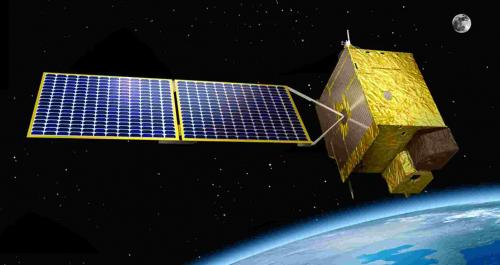Diurnal variation of different pollutants at city scale
Reactive atmospheric gases characterized by short lifetimes and local emission sources exhibit a large variability in space and time. Photochemical processes lead to diurnal cycles of their concentrations, superimposed on seasonal and interannual variability.
An international constellation of polar (LEO) satellites providing daily global measurements and geostationary (GEO) satellites providing hourly regional measurements has been elaborated, of which GEMS (Geostationary Environment Monitoring Spectrometer) onboard the GEO-KOMPSAT-2B satellite is the first in operation.
Since its launch in February 2020, GEMS contributes to the monitoring of several trace gases and aerosols over East Asia. The high spatial and temporal resolutions (up to 8 times per day at a nadir resolution of 3.5 × 8 km2) allow studying the diurnal variation of the different pollutants at the city scale, which is not possible with satellite instruments mounted on LEO platforms.
Validation of operational GEMS products
However, satellite data retrievals are critically dependent on instrumental performances and calibration, and on several a-priori assumptions (or retrieval choices) about the vertical distribution of the pollutants, interferences with clouds and aerosols, atmospheric temperature, and surface properties. Independent geophysical validation of the retrieved trace gas products, including uncertainty characterization, is therefore a prerequisite to the proper use of the data. Validation also provides useful feedback for the improvement of the satellite data retrieval algorithms.
BIRA-IASB is involved in the validation of operational GEMS products and supports the Korean teams in the development of the retrieval of gases such as NO2, HCHO, CHOCHO, SO2 and O3.
GEMS is a pioneering case for the upcoming American TEMPO mission (to be launched in 2023) and the European Sentinel-4 that should follow in 2024. In this future geostationary constellation, the role of validation is a key in ensuring the interoperability with other instruments and the coherence of the retrieved data above the different parts of the globe.
BIRA-IASB is following practices developed and applied within the operational validation of trace gas data from Sentinel-5 Precursor TROPOMI (within ESA’s Mission Performance Cluster) and Metop GOME-2 (within the Atmospheric Composition Satellite Application Facility). It relies on the analysis of data retrieval diagnostics and on comparisons with correlative measurements acquired by MAX-DOAS, Zenith-Scattered-Light (ZSL) DOAS, Pandora, Fourier-transform infrared spectrometers (FTIR), Brewer, Dobson ground-based instruments, ozone sondes and comparisons with LEO instruments.
References
- Data GEMS L2 images (Environmental Satellite Center Korea)
- Won Jun Choi et al., "Introducing the geostationary environment monitoring spectrometer," J. Appl. Rem. Sens. 12(4) 044005 (27 December 2018) https://doi.org/10.1117/1.JRS.12.044005

